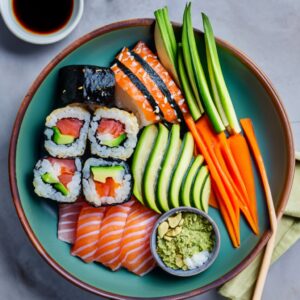
Embark on a culinary journey to Japan with our delectable Sushi Bowl recipe. Bursting with vibrant colors, bold flavors, and nourishing ingredients, this dish offers all the exquisite taste of traditional sushi in a convenient bowl format. Whether you’re a sushi aficionado or new to Japanese cuisine, our Sushi Bowl promises to tantalize your taste buds and awaken your senses with every bite. Prepare to indulge in a harmonious blend of fresh fish, crisp vegetables, and savory rice, perfectly combined to create a delightful culinary experience. Join us as we celebrate the art of sushi-making and savor the essence of Japan in every mouthful.
Sushi Bowl Recipe

how to make a sushi bowl
Ingredients:
- 2 cups sushi rice
- 3 tablespoons rice vinegar
- 2 tablespoons sugar
- 1 teaspoon salt
- 1 large cucumber, julienned
- 2 large carrots, julienned
- 1 ripe avocado, sliced
- 1/2 cup edamame, cooked
- 4 ounces sushi-grade raw salmon or tuna, thinly sliced
- 1 tablespoon sesame seeds
- Soy sauce, for serving
- Pickled ginger, for serving
- Wasabi, for serving
- Nori seaweed, shredded, for garnish (optional)
Instructions:
- Prepare the Sushi Rice:
- Rinse the sushi rice under cold water until the water runs clear.
- Cook the rice according to the package instructions.
- In a small bowl, mix the rice vinegar, sugar, and salt until dissolved.
- Once the rice is cooked, transfer it to a large bowl and gently fold in the vinegar mixture until well combined. Allow the rice to cool to room temperature.
- Assemble the Sushi Bowl:
- Divide the sushi rice among serving bowls.
- Arrange the julienned cucumber, carrots, sliced avocado, cooked edamame, and raw fish over the rice in sections.
- Garnish and Serve:
- Sprinkle sesame seeds over the sushi bowl.
- Serve with soy sauce, pickled ginger, and wasabi on the side.
- Optionally, garnish with shredded nori seaweed for added flavor and texture.
- Enjoy!
- Mix the ingredients together before eating to combine all the flavors.
- Serve immediately and enjoy the deliciousness of your homemade Sushi Bowl!
tips for Sushi Bowl recipe

Here are some tips to enhance your Sushi Bowl recipe:
- Use Sushi-Grade Fish: When selecting raw fish for your Sushi Bowl, ensure it is labeled as sushi-grade. This guarantees freshness and safety for raw consumption.
- Perfectly Cooked Rice: Cook the sushi rice according to the package instructions and ensure it is cooked to perfection. The rice should be tender and slightly sticky, but not mushy.
- Season the Rice: Mix the rice vinegar, sugar, and salt thoroughly before folding it into the cooked rice. This seasoning adds flavor and helps the rice grains stick together.
- Get Creative with Toppings: Feel free to customize your Sushi Bowl with your favorite toppings. Aside from the suggested ingredients, you can add ingredients like sliced radishes, mango, or tobiko (flying fish roe) for additional flavor and texture.
- Garnish with Nori: Sprinkle shredded nori seaweed over the Sushi Bowl for an authentic touch and added umami flavor.
- Serve with Condiments: Provide soy sauce, pickled ginger, and wasabi on the side for dipping. This allows each person to adjust the flavors according to their preference.
- Keep it Fresh: Serve the Sushi Bowl immediately after assembling to enjoy the freshness of the ingredients and the vibrant flavors.
- Experiment with Presentation: Have fun with the presentation of your Sushi Bowl. Arrange the toppings in an aesthetically pleasing manner to make your dish visually appealing.
- Prep Ahead: You can prepare some components of the Sushi Bowl, such as cooking the rice and cutting the vegetables, ahead of time to streamline the assembly process.
- Enjoy the Experience: Making and eating a Sushi Bowl is all about enjoying the process and savoring each bite. Get creative, experiment with flavors, and most importantly, have fun in the kitchen!
By following these tips, you can create a delicious and visually stunning Sushi Bowl that will impress your friends and family.
Sushi Bowl nutritional value
| Nutrient | Amount Per Serving |
|---|---|
| Calories | 450-500 calories |
| Total Fat | 10-15 grams |
| Saturated Fat | 1-2 grams |
| Cholesterol | 30-40 milligrams |
| Sodium | 500-600 milligrams |
| Total Carbohydrates | 70-80 grams |
| Dietary Fiber | 8-10 grams |
| Total Sugars | 5-8 grams |
| Protein | 20-25 grams |
how to store Sushi Bowl leftovers
Storing leftover Sushi Bowl properly is essential to maintain its freshness and prevent foodborne illnesses. Here’s how to store leftovers safely:
- Cool Down Quickly: Allow the leftover Sushi Bowl to cool down to room temperature before storing it in the refrigerator. This helps prevent bacterial growth.
- Use Airtight Containers: Transfer the leftover Sushi Bowl into airtight containers to keep it fresh and prevent moisture loss. Make sure the containers are suitable for storing food and have tight-fitting lids.
- Separate Components: If possible, separate the components of the Sushi Bowl, such as rice, vegetables, and fish, into different containers. This prevents the flavors from mixing and helps maintain the quality of each ingredient.
- Label and Date: To keep track of freshness, label the containers with the contents and date of storage. This will help you identify how long the leftovers have been stored and when they should be consumed.
- Refrigerate Promptly: Place the airtight containers of leftover Sushi Bowl in the refrigerator as soon as possible, ideally within two hours of preparation. Store them on the refrigerator shelves, not the refrigerator door, to ensure proper cooling.
- Consume Within a Few Days: Leftover Sushi Bowl can typically be stored in the refrigerator for up to 2-3 days. Beyond that, the quality may deteriorate, and there’s an increased risk of foodborne illness.
- Reheat Safely (Optional): If you prefer to eat the leftover Sushi Bowl warm, reheat it gently in the microwave or on the stovetop until heated through. Make sure to stir the components evenly to ensure even heating.
- Discard if Necessary: If the leftover Sushi Bowl develops an off smell, unusual texture, or signs of spoilage, such as mold or discoloration, discard it immediately to avoid foodborne illness.
By following these guidelines, you can safely store and enjoy leftover Sushi Bowl without compromising on taste or safety.
benefits of eating this sushi bowl

Eating a Sushi Bowl offers numerous health benefits due to its nutrient-rich ingredients. Here are some potential benefits of enjoying a Sushi Bowl:
- High in Protein: The sushi-grade raw fish, such as salmon or tuna, provides a significant amount of high-quality protein, which is essential for muscle repair, growth, and overall health.
- Rich in Omega-3 Fatty Acids: Raw fish, particularly salmon and tuna, are excellent sources of omega-3 fatty acids, which are beneficial for heart health, brain function, and reducing inflammation in the body.
- Good Source of Fiber: Vegetables like cucumber, carrots, and avocado in the Sushi Bowl are rich in dietary fiber, which supports digestion, helps maintain a healthy weight, and keeps you feeling full and satisfied.
- Healthy Carbohydrates: Sushi rice, made from short-grain rice seasoned with rice vinegar, sugar, and salt, provides a source of complex carbohydrates that offer sustained energy and support overall health.
- Essential Vitamins and Minerals: The assortment of vegetables and fish in the Sushi Bowl provides a variety of essential vitamins and minerals, such as vitamin C, vitamin A, potassium, and magnesium, which are important for various bodily functions and overall well-being.
- Antioxidants: Ingredients like edamame, avocado, and seaweed (nori) contain antioxidants that help protect cells from damage caused by free radicals, reducing the risk of chronic diseases and promoting overall health.
- Low in Unhealthy Fats: While fish like salmon and tuna contain healthy fats, they are low in saturated fats and cholesterol, making the Sushi Bowl a heart-healthy option when consumed in moderation.
- Customizable and Balanced: The beauty of a Sushi Bowl lies in its versatility and adaptability. You can customize the ingredients to suit your taste preferences and dietary needs, ensuring a balanced meal that meets your nutritional requirements.
Overall, incorporating a Sushi Bowl into your diet can contribute to a well-rounded, nutritious eating plan and provide a delicious way to enjoy the health benefits of fresh, whole foods.
FAQ’S
What is the difference between a poke Bowl and a sushi bowl? While both poke bowls and sushi bowls feature a base of rice topped with fresh ingredients, they differ in their main components. Poke bowls typically consist of cubed raw fish (usually marinated in soy sauce and sesame oil), while sushi bowls include sliced raw fish or seafood along with other traditional sushi ingredients like avocado, cucumber, and seaweed. Additionally, poke bowls may have a Hawaiian influence with ingredients like pineapple or mango, whereas sushi bowls stick to more traditional Japanese flavors.
What is a good side for sushi? Common side dishes for sushi include miso soup, edamame, seaweed salad, pickled ginger, and Japanese-style cucumber salad (sunomono). These sides complement the flavors of sushi and provide a balance of textures and tastes.
What to eat with sushi rice? Sushi rice pairs well with a variety of dishes, including grilled or steamed vegetables, teriyaki chicken or tofu, tempura, sashimi, and seaweed wraps. You can also enjoy sushi rice as a base for poke bowls, sushi rolls, or sushi bowls.
Is poke bowl really healthy? Poke bowls can be a healthy option, especially when loaded with fresh vegetables and lean protein like raw fish or tofu. However, it’s essential to be mindful of portion sizes and the ingredients used in the poke bowl, as toppings like fried tempura or creamy sauces can add extra calories and unhealthy fats.
Is sushi or poke healthier? Both sushi and poke can be healthy choices when made with fresh, high-quality ingredients. Sushi tends to have more variety in terms of seafood options and traditional Japanese flavors, while poke bowls offer customization and may include more diverse toppings like fruits and vegetables. Ultimately, the healthiness of either dish depends on the specific ingredients and portion sizes.
Is it okay to eat sushi rice everyday? Eating sushi rice occasionally as part of a balanced diet is generally fine for most people. However, consuming sushi rice or any other food in excess can contribute to an imbalance in nutrients or calorie intake. It’s essential to practice moderation and incorporate a variety of foods into your diet for optimal health.
Can I eat sushi rice like regular rice? Yes, you can eat sushi rice like regular rice. Sushi rice is simply short-grain rice seasoned with rice vinegar, sugar, and salt, making it slightly tangy and sticky. It can be enjoyed as a side dish, in sushi rolls, or as a base for sushi bowls or poke bowls.
What are the 2 things served with sushi? The two common accompaniments served with sushi are soy sauce (for dipping) and pickled ginger (to cleanse the palate between bites). Wasabi, a spicy Japanese horseradish paste, is often provided alongside soy sauce and pickled ginger for added flavor.
